This February I shared nine ways you can Go Red during American Heart Month (and beyond) to make a difference for yourself and others. This series will provide more information and resources on each of them. Today’s post: Get up.
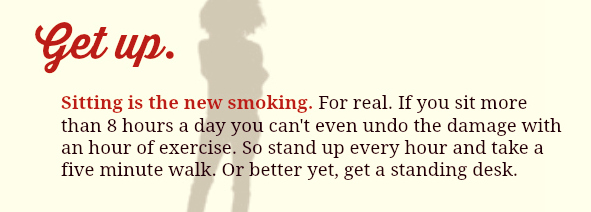 I would never start smoking, so why would I start sitting? This post is republished from Borealis, a blog I write with my friend and co-author Breanne. We hope it inspires you to try a standing desk too.
I would never start smoking, so why would I start sitting? This post is republished from Borealis, a blog I write with my friend and co-author Breanne. We hope it inspires you to try a standing desk too.
Why we love our standing desks
by Breanne Hegg
Like we often do, because great minds think alike, Jen and I decided independently to get standing desks this year. If you’ve read any of the research, they are calling sitting the new smoking, and saying that even if you exercise regularly you cannot overcome the adverse affects of sitting at your work all day. I’ve long been envious of my teacher-husband for the built-in fitness in his day, but I like office work. And at 35, I have a lot of working years left.
We both decided to just take the plunge and buy them for ourselves, instead of repeatedly haranguing our workplaces to get them for us. It is easy to balk at the price – ours were both in the $200-300 range, but once I imagined that little price tag appearing at the bottom of a doctor’s office bill, the decision was easy. Three hundred dollars spread over 30 more working years is a ridiculously good investment in your health.
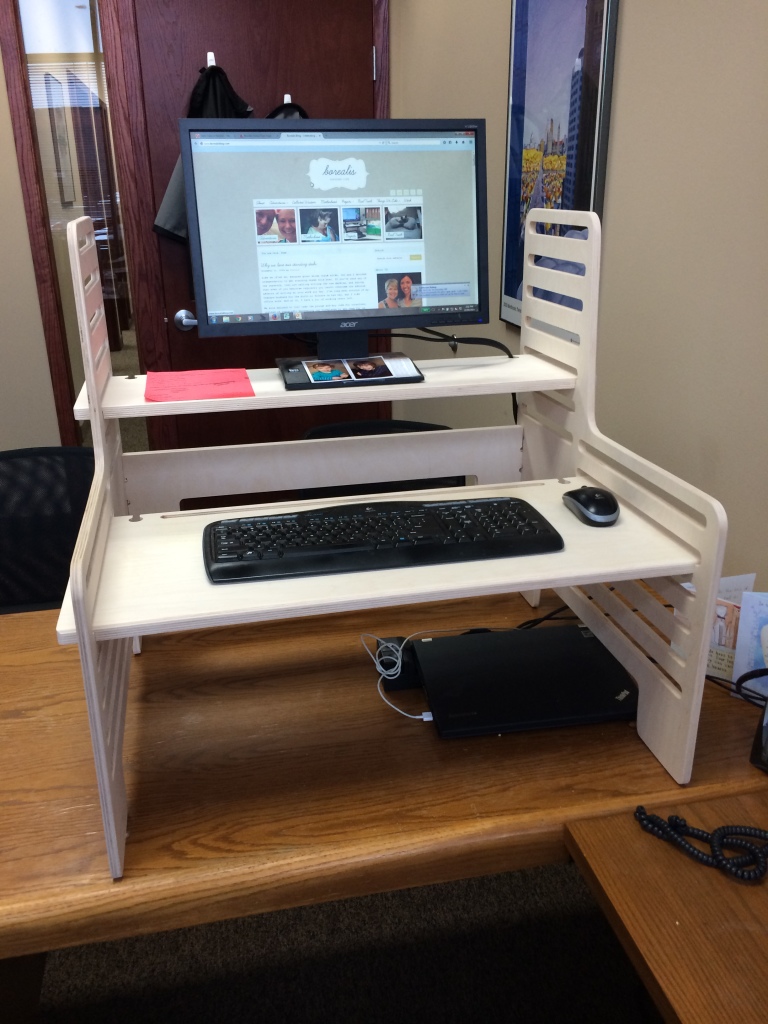 I was a little worried I wouldn’t be able to hack standing all day, but I haven’t had a problem. Like most office workers I have meetings throughout the day that I sit at, and I join my coworkers for a seated lunch. And I still have an office chair — an exercise ball, actually – that I can use if I want to sit. I don’t wear heels, so haven’t had to alter my footwear, although I am careful to wear cushion-y socks (e.g. tights won’t cut it).
I was a little worried I wouldn’t be able to hack standing all day, but I haven’t had a problem. Like most office workers I have meetings throughout the day that I sit at, and I join my coworkers for a seated lunch. And I still have an office chair — an exercise ball, actually – that I can use if I want to sit. I don’t wear heels, so haven’t had to alter my footwear, although I am careful to wear cushion-y socks (e.g. tights won’t cut it).
Here are some things that surprised me about having a standing desk:
- I like it that when people come into my office, it’s easier to talk because we are standing together, and it’s not the usual awkward uneven power dynamic. (I summon you to my office, where you stand while I sit and receive you. . .)
- I didn’t realize how that slight effort of standing up is a deterrent, and how it’s so much easier to pop out to talk to a coworkers one-on-one (or fetch a coffee refill) if you are already standing. It makes my work seem more seamless, instead of trading off sitting phases with standing/moving, I’m always moving.
- Standing gives me an odd little productivity boost, where I feel a bit like a super efficient airline desk officer. Maybe like how they say you should stand in the power Superman position right before an interview because it gives you confidence, the power position of standing gives you productivity?
- Standing desks also elevate you from the clutter of your desk also make it much harder to spill your coffee on your keyboard.
The other main reason I got a standing desk is because of neck discomfort and headaches. I have trouble not cranking my neck upward unnaturally when sitting and by midday am usually cracking and massaging my sore shoulders. With standing it’s a lot easier to have good posture, and my neck pain is much improved.
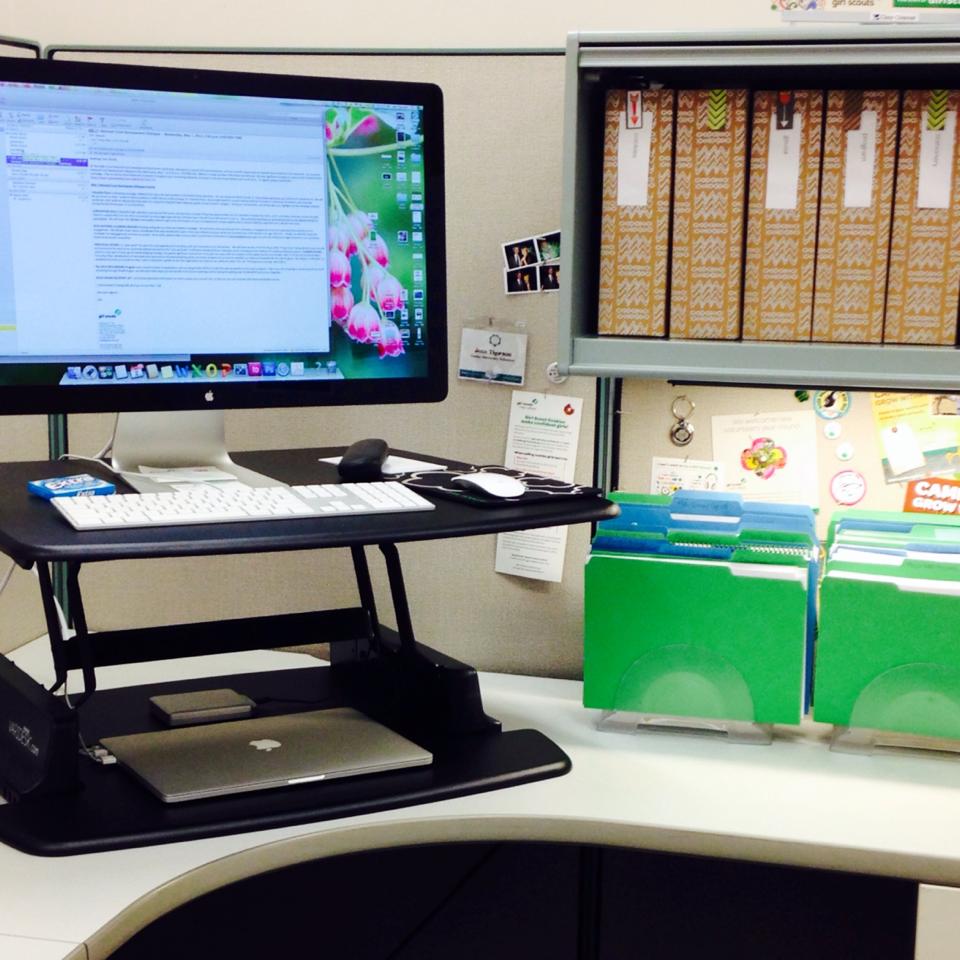 (Jen’s original setup; after a few weeks of being startled by people coming in behind her, she moved it to the other side of her u-shaped desk so her back wasn’t to the door. Also probably not the best view.)
(Jen’s original setup; after a few weeks of being startled by people coming in behind her, she moved it to the other side of her u-shaped desk so her back wasn’t to the door. Also probably not the best view.)
Jen has had her standing desk for nine months and says she doesn’t intend to sit down again, ever. Here are a few observations about her standing desk:
- I started working again two years after my heart attack — and after three years of hardly sitting at all, it seemed unwise at best (and scary at worst) to start sitting all day. I’d never start smoking, of course, so why start sitting?
- After the first week or so, I wasn’t even tired at the end of the day. In fact, I never get the mid-afternoon drowsy/foggy feeling anymore. And like Breanne, I never have sore/tired/tense neck and shoulders anymore either.
- I also noticed that my obliques were sore for the first couple weeks and they aren’t anymore; that tells me that standing at work is a core strengthener too.
- I have a fatigue mat (like retailers use for checkout staff) and that helps a lot. I do wear heels, every day, and it works fine.
- I’ve noticed that when people stop in to talk to me we both stand and conversations are faster and more focused. If I have a scheduled meeting, though, we move to my little conference table and I do sit down then.
- My desk can easily move up and down but I leave it up all the time. If I were to purchase again, I’d get one with some writing space to the side of my keyboard and/or some space to lay a document that I’m referencing — like this one meant for two monitors.
- If I’m talking on the phone, I sit down on my desk. I do this every time. I have no idea why.
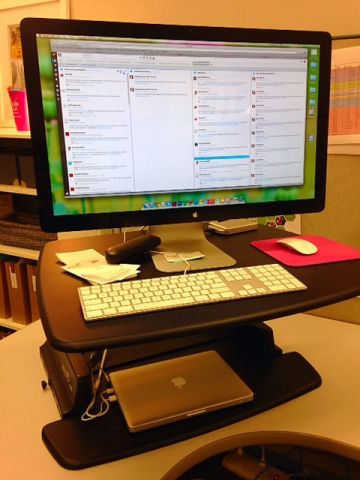 If you’re curious, Breanne purchased the all-wood Upstanding Desk ($200 + shipping, although she got a discount after it arrived two months late), and Jen got the Varidesk Single ($275).
If you’re curious, Breanne purchased the all-wood Upstanding Desk ($200 + shipping, although she got a discount after it arrived two months late), and Jen got the Varidesk Single ($275).
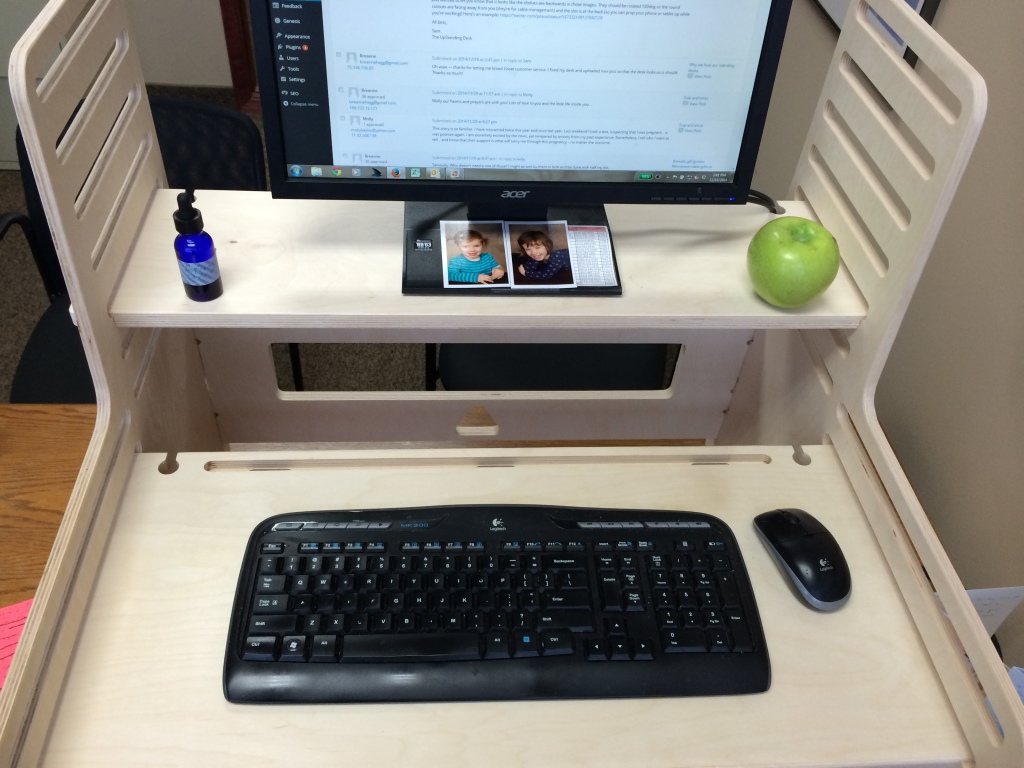



Here is a link to an article I came across on the Mayo Clinic Facebook page yesterday.
http://www.mensjournal.com/health-fitness/health/sitting-the-most-unhealthy-thing-you-do-20150219?linkId=12534664
Your Guide to Sitting Less
1. Plan by Minutes
Cornell ergonomist Alan Hedges recommends 20 minutes sitting, 8 minutes standing, 2 minutes walking. Repeat. The formula also improves productivity and posture, studies show.
2. Default to a Walk
Instead of mulling at your desk when you’re drawing a blank, get up and take a 5-minute walk. Research suggests that you’ll be 60 percent more creative when you return.
3. Stand When Tired
Make this automatic: If you yawn, stand up. Rising fires the Ascending Reticular Activating System, a network of neurons in the cerebral cortex that enhances alertness.
4. Shift Your Mind-Set
Before you take a seat, think of this quote from Mayo Clinic researcher James Levine: “The goal of sitting should be sin-gular: to give our bodies a break from moving.”